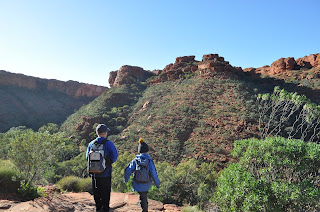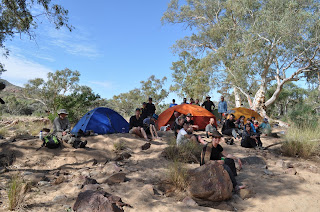When I look at a map and see a dashed line indicating a dirt road, I think pot holes, bull dust or large muddy puddles, corrugation and top speeds of 50 kph. However, right now the Oodnadatta Track is not that.
We'd packed up super fast after a frosty morning in Uluru and were on the road by 8am. We made Marla, over the SA boarder for lunch and shared a picnic table with a FTO3m (Family Time Out for 3 months) who'd just come up the Track. They said that the recent rains had left the track is a beautiful smooth condition, and that's all it took to convince Evan that the Oodnadatta Track was the way home. He also thought or hoped that the suspension on the camper could handle it, so our destination for the night was now William Creek, 180km east of Coober Pedy.
The FTO were right, we were cruising the dirt at 90 kph with the salt bush plains stretching on for miles with not a tree in sight. The rains had brought fields of flowering white daisies beside the road. Flocks of corellas lifted from the pool of the flat salt lake pans and as the sun set we arrived at William Creek, a one pub 'town' with a runway and a caravan park. This is what we'd been missing. So glad to be away from the crowds and tourists at the Red Centre.
This is a very historic part of the country. The Ood or The Dat Track follows the old Ghan railway line and all the ruined sidings and buildings to go with it. We spent today slowly making our way south with many stops along the way to collect railway nails, explore old ruins, climb water tanks, squelch through the salt crusted bed of Lake Eyre, up to our ankles in mud. We made Marree for lunch and stopped in at the Lake Eyre Yaught Club. Yep, this old dude had a catamaran and whenever there is more than 80mm of water in the lake he goes sailing, sometimes for days or weeks at a time, towing a canoe with all his supplies!
Back on the road and there is a tiny little ruined town called Farina which some oldies are trying to restore. There is an old bakery with oven built underground and they have the bakery up and running. We stopped in for a pie, cinnamon scroll and an amazing custard tart. It's in the middle of nowhere but hopefully they get the passing tourists on their way to the Strzelecki, Birdsville and Oodnadatta tracks.
The further south we drove the hillier the country became with the beginning of the magnificent Flinders Ranges to our left. There were also a few flocks of emus, sheep and finally some trees.
Parachilna is another blip on the map with a pub and an old school house, turned 'caravan park' ie there's a toilet/ shower block and gas BBQ. We're here for the night with 4 other people and it's nice that there's no white noise of a generator, like we'd been getting used to in the 'overflow' camp sites.























































